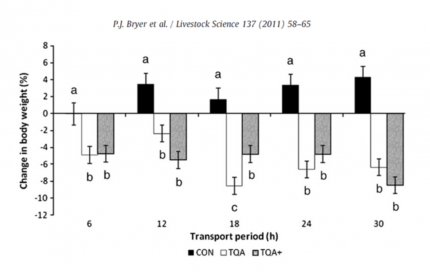
Our recent discussions with technical teams from several genetic companies proved to us that they are concerned about stress during transport. Gilts have a high value and any claim related to transport is costing them significant amounts of money and damaging their reputation.
What does research say about this?
Even if there is not a lot of data to guide us, we can mention one study by Bryer and coworkers (2011), on replacement gilts and the effects of transport duration on replacement gilts and the amount of space provided during the trip. Gilts, weighing about 90kg, were transported for 6, 12, 18, 24, or 30 hours, in a straight-deck livestock trailer that had been modified to create compartments in order to hold four gilts in two different space allowances. They followed Transport Quality Assurance (TQA) recommendation (0.33 m² per gilt) or TQA + 20% (0.37 m² per gilt). Prior to transport, gilts had been moved into their treatment groups and given 72 hours to acclimate to their pen-mates. Therefore, stress related to mixing was reduced.
The research took place in temperate weather in Texas, USA. Stress indicators and weight were measured. The changes in metabolites, enzymes, and (or) hormones were inconclusive, but percent change in body weight of gilts (see the figure below), suggested that most weight loss occurs in the first six hours, and that there was no difference from 30 hours of transport, irrespective of the space allocation.

The authors could not conclude that one duration of transport or space was preferential, but they confirmed that transport of gilts creates stress and changes in homeostasis, likely due to dehydration and fasting. We should note that the study does not provide information about the impact of mixing and social interactions among gilts occurring during transport, such as those that would normally occur in a commercial situation. These interactions, combined with duration of transport and space provided, should lead to even more stressful conditions.
And in practice?
Our discussions with some companies importing (for example) gilts from Germany into Romania indicate that at this time of the year, they are losing about 6.5kg per gilt (in the last shipment, for 160 animals in one truck, they lost from 15,860kg to 16,900 kg, which is 6.5kg per gilt). This is not during summer where losses can be as high as 10kg per animal!
What does it mean in terms of value?
A F1 gilt weighing 100kg is sold between €250 and €350, while a GP gilt is sold between €700 and €1,100 per head. This does not include the royalty system that genetic companies will charge for GP stock. The real value of a GP sow could be above €2,000.
Even if the price of a gilt will not be based on its weight on arrival, any loss of performance or impaired health due to transport can generate significant claims for the genetic companies.
Take Home Message
Transportation of breeding gilts is creating stress and results in body weight loss due to dehydration and fasting. It also can lead to reduced value of the animals.
We know that Tonisity Px or Tonisity PxW will increase water intake and promote rehydration, helping to reduce the consequences of stress. We are now discussing with some genetic companies how we can do some trials with them.
We also encourage you to discuss with their local representatives and make them aware that you can help.
Once again, we know that most of these genetic companies are concerned about stress during transport of these valuable animals.

